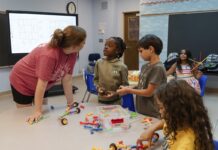
The grim statistics of COVID-19 include more than just the number of cases, hospitalizations, and deaths.
A national report says Georgia has the highest percentage in the nation of families with children concerned about losing their housing in the next month due to income loss from the pandemic.
The report from the Annie E. Casey Foundation, released Monday, found 58 percent of Georgia adults with children said they were worried about eviction or foreclosure. And homelessness poses health risks to people of any age.
The report also revealed that Georgia has the second-highest rate of uninsured adults with children in their households, at 19 percent, higher than the national average of 12 percent.
And 16 percent of parents in Georgia reported that their families sometimes or often did not have enough to eat in the past week, versus the national average of 14 percent.
That’s reflected in unprecedented demand at Georgia food banks.
“Georgia’s food banks are responding to a 50 percent increase in demand that surged in March and continues today,’’ said Georgia Food Bank Association Executive Director Danah Craft.
“Kids who are food insecure are more likely to have poor health overall, getting sicker more often and needing more care,’’ Craft said. “Adults who don’t have the food they need are more likely to miss work and have a difficult time holding down a job, compounding the crisis. We’re the final backstop to keep families from falling into complete crisis, and additional support for children and families in Georgia is vital.”
The pandemic has disproportionately hurt communities of color, the report noted. African-American and Latino adults with children reported food insecurity at twice the rate of white Georgians, and were significantly more likely to be concerned that they would not be able to afford usual household expenses, according to the report.
The report, called Kids, Families, and COVID-19: Pandemic Pain Points and the Urgent Need to Respond, was generated from data collected in a weekly U.S. Census Bureau Household Pulse Survey.
Erica Fener Sitkoff, executive director of the advocacy group Voices for Georgia’s Children, said the report illuminates the hardships that kids are facing during the pandemic.
“Growing up is hard enough,’’ she said. “The exceptional loss kids are experiencing now and into the future requires exceptional attention. And action should be specific to each community.’’
Economic fallout hits home
Fear of eviction is a widespread problem during the COVID-19 crisis. Many families have lost income and cannot make the payments necessary to remain where they live. In turn, many landlords and lending institutions are themselves under financial pressure with the payments no longer coming in.
CNN reported recently that more than 14 million American households are currently at risk of eviction, according to Stout, a global investment bank and advisory firm. And 4.9 million of them are likely to receive eviction notices in January after the CDC eviction moratorium expires Dec. 31, CNN reported.
“Every child in the United States should have the basics, and families should have support to survive the considerable stress and pain of these times,” Lisa Hamilton, president and CEO of the Annie E. Casey Foundation, said in a statement. “Our leaders can respond to the COVID-19 crisis by putting equity first, prioritizing children’s physical and mental health, helping families achieve financial stability, and strengthening schools so kids can thrive in spite of the extraordinary times.”
The report’s data also underscore the mental health toll experienced during the pandemic, with more than 30 percent of adults with children in Georgia reporting they had felt anxiety in the past week, and more than 20 percent reporting they had felt down, depressed, or hopeless in the past week.
Over the course of the pandemic, the nation’s education system has been turned upside down.
Nearly all schools in the United States closed for at least part of spring 2020. By fall, some children were attending school in person, others were learning remotely and others were following a hybrid approach. Many kids have found virtual learning challenging, the report noted.
One positive trend in Georgia is that children’s access to devices for digital learning has improved across racial and ethnic lines. In July, 76 percent of African-American students had access to devices for digital learning, but by September, that rate had risen to 95 percent. On average, Georgia’s device access increased from 80 percent in July to 94 percent in September, exceeding the national average of 93 percent.






